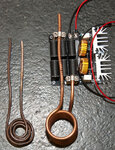Veketti
Full Member level 3
Dear All,
Recently I bought from ebay 20A ZVS induction heater and my purpose was to annel brass with it. Problem that I faced is that it is very inefficient to brass. Works well on steel though. So I decided to make new coil for it to concentrate the power to smaller area. Ok, so I bought some brake line copper (seems to be Cu-Ni instead of pure copper). I thought that as long as the coil has same inductance it would work. I was wrong. Both are now ~1.3uH but induction heater seems like shorted and doesn't start to oscillate with this self made coil.
My question to someone who understands how these work is what is the important factor that needs to be met with smaller diameter heating coil to make it work? Could it be the resistance of the coil? The original is 2.43 mohm and fabricated is 27.5 mohm.
Here's the picture of the device and the coils. Self made looks like birds nest but it wasn't too easy to wound three layers without shorting the coils. :lol:

Thank you in advance. Really appreciate your help.
Recently I bought from ebay 20A ZVS induction heater and my purpose was to annel brass with it. Problem that I faced is that it is very inefficient to brass. Works well on steel though. So I decided to make new coil for it to concentrate the power to smaller area. Ok, so I bought some brake line copper (seems to be Cu-Ni instead of pure copper). I thought that as long as the coil has same inductance it would work. I was wrong. Both are now ~1.3uH but induction heater seems like shorted and doesn't start to oscillate with this self made coil.
My question to someone who understands how these work is what is the important factor that needs to be met with smaller diameter heating coil to make it work? Could it be the resistance of the coil? The original is 2.43 mohm and fabricated is 27.5 mohm.
Here's the picture of the device and the coils. Self made looks like birds nest but it wasn't too easy to wound three layers without shorting the coils. :lol:

Thank you in advance. Really appreciate your help.